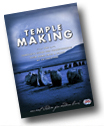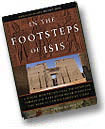
 |
||||||
 |
|||||||||||||||||||||
|
T 448 (Andrews Catalogue) O is the center of circles 1,2,3, and the center of equilateral triangle ADE. ABC is also equilateral with height AD. The moon has center D, radius AD. But OB is also a height of triangle ABC, therefore circle 3 with radius OB is the same size as the moon. Circle 2 is tangent to the moon on OD produced, and circle 1 is the exterior circle of the hexagon tangent to circle 2. This construction fits the crop formation to within the limits of measurement, and we can find the areas of the circles exactly. They give diatonic ratios. From 1 to 2 we get a ratio of 4/3, and from 1 to 3 we get closely a ratio of 10/3. This geometry is repeated three times by rotating 60º and 120º. The terminator or shadow-line of the moon is an arc of radius CB centered on C. Point B is exactly at the middle of the terminator, and exactly where circle 3 intersects the terminator. The circle of the disc of the moon also passes through E, that is why it touches circle 2 on OD produced. This makes the tip of the moon in the crop formation curve-in slightly from the outer circle. Is this all an artistic accident, or is it clever design? Are we suppoed to discover where the triangles are,and the exact sizes of the three circles, 1,2, and 3? Is it confirmation of our work that when we get the answer the circles give diatonic ratios? The six outer loops are embellishments giving a hint of the hexagon. The formation gives the rotational geometry, accurate to a few inches on the ground. The music notes are F and A in the second octave. |
|||||||||||||||||||||
 |
|||||||||||||||||||||
 |
|||||||||||||||||||||
|
T367 (Andrews catalog) Does this represent the sun and planets? The orbits are exact circles with slighly different centers and diameters of 0.5, 0.7, 1.4, and 2.6. Mercury, Venus, Earth, Mars, and the Asteroids have actual values of 0.4, 0.7, 1.5, and 2.8 --a pretty good fit. If so the nearest date indicated is 11 July 1971. One of the next dates is 30 August 2033, years away because we have to match the motion of three planets, Mercury, Venus, and Mars. By computer graphic measurement the Asteroid circle and the edge-circle beyond Mars give a diatonic ratio of 9/4, note D in the second octave. (See CPRI Newsletter, Autumn/Winter 1995/1996, and 1996/1997). In astronomy, angles are measured counterclockwise from the over-size Sun at the center. The closest approach of Mercury to the Sun (perihelion) is at 75 degrees, and the angles for Mercury, Venus, and Mars are 189 degrees, 76 degrees and 303 degrees. The Asteroid belt is symbolic and does not give the position of any Asteroid in its orbit. |
|||||||||||||||||||||
 |
|||||||||||||||||||||
|
T370 (Andrews catalog) This shows the equal-ring branch of theorem five. Eight equally-spaced rings are needed before you get to a non-equilateral diatonic triangle. It fits with the vertices on ring 8, and sides touching rings 7 and 2. It's an 8-7-2 triangle, diatonic ratio 16, note C in the fifth octave. Measurements in the field by Dowell and Vigay are in agreement with this photogrammetry. Is this confirmed by the outer loop of circles? Perhaps so, because tangents to ring 7 exactly intersect at the ring of the outer loop, and the circles on this ring have diameters of 7 units.
Text © Gerald Hawkins 1997 Photos, photo corrections and diagrams© Freddy Silva 1997
Forward to Part 2 of Latest Work Forward to Part 3 of Latest Work |
|||||||||||||||||||||
 |
 |
 |
 |
||||||||||||||||||
 |
|||||||||||||||||||||
 |
|||||||